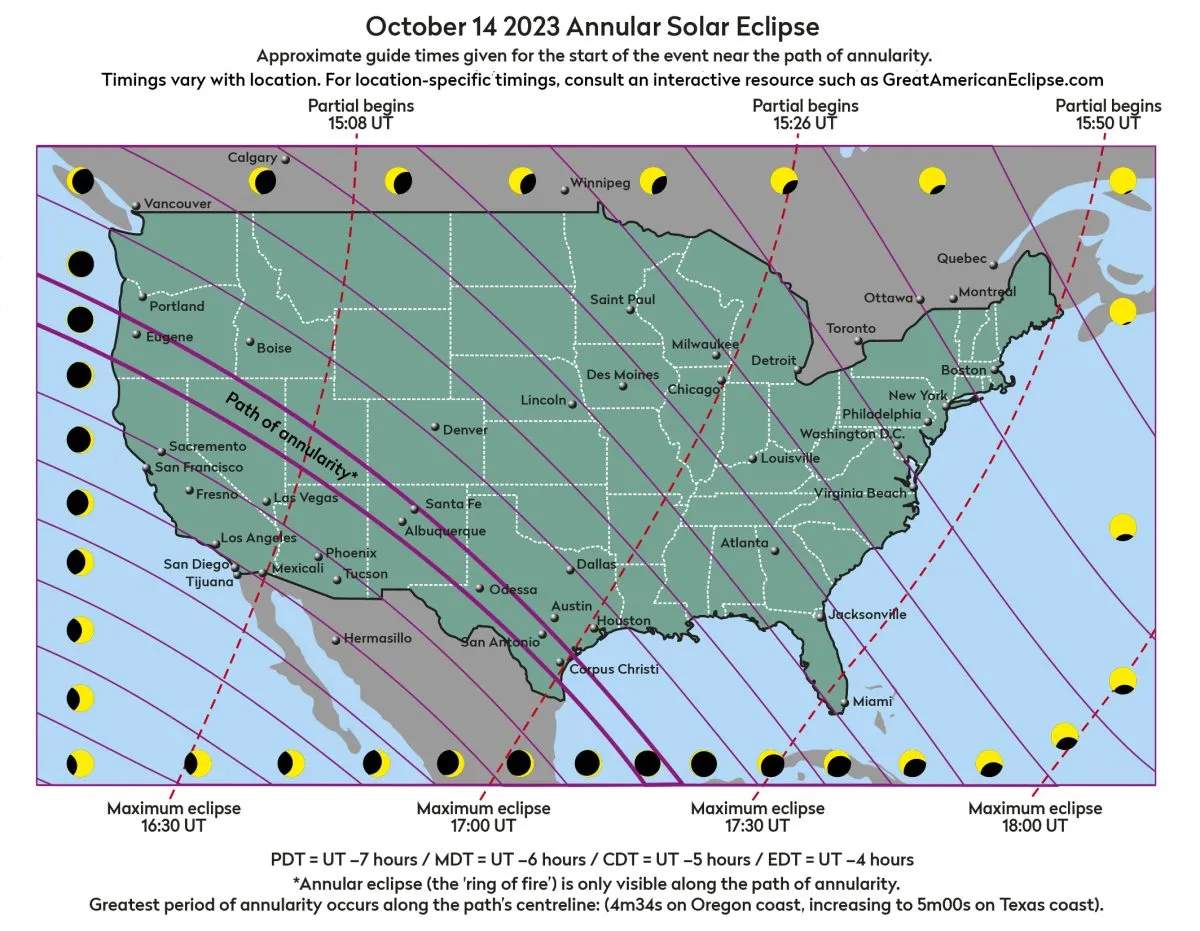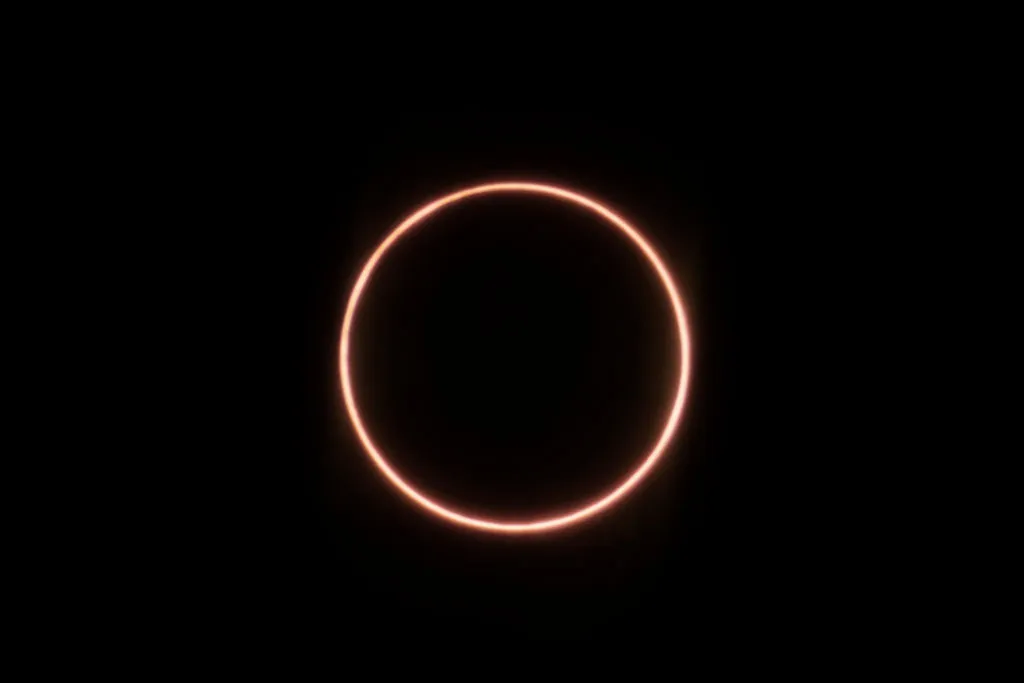This weekend's annular solar eclipse on October 14 is one of the most anticipated astronomical events of 2023.
Saturday will bring about a spectacular eclipse phenomenon that observers in North and South America have been looking forward to all year
The annular solar eclipse of October 14 2023 – also called a ‘ring of fire’ eclipse – will be watched by millions of people.
It will pass across 10 countries and running a decent path down through the US.

For the US, the October eclipse will be something of a warm-up to a long total solar eclipse exactly 177 days later on 8 April 2024.
However, the sight of a bright ring around the Moon — something that can only be viewed safely using solar filters – will be something to savour for eclipse-chasers.
As well as lasting for up to 5 minutes 17 seconds, it’s way more accessible that the four remaining ‘ring of fire’ eclipses this decade in the Pacific, Patagonia, the Amazon and Siberia.
What is an annular solar eclipse?

An annular solar eclipse occurs when the Moon’s apparent size in the sky is slightly too small to completely cover the Sun’s disk, leaving an annulus visible around the Moon’s silhouette for a few minutes.
An annular eclipse is commonly called a ‘ring of fire’. It occurs because the Moon has a slightly elliptical orbit of the Earth and is slightly too far away for its shadow cone to touch the Earth’s surface.
During this eclipse, the Moon will cover almost 91% of the Sun's disk.
October 14 solar eclipse location map

October 14 solar eclipse timings

The October 14 eclipse will bring a big partial solar eclipse to all of North America and much of South America this weekend.
It has a narrow ‘path of annularity’ that starts south of Alaska (see map above).
This path of annularity marks locations from where the full annular eclipse will be visible.
On October 14 the Moon's shadow will move across the US, Mexico, Belize, Guatemala, Honduras, Nicaragua, Costa Rica, Panama, Colombia and Brazil.
At its widest, the path of annularity will reach about 140 miles. The maximum duration of the ‘ring of fire’ will be just off the coast of Nicaragua in the Gulf of Mexico.

In the US the October 14 eclipse will begin in Oregon at 9:13 am PDT and move southeast, leaving Texas at 12:03 pm CDT.
Although the iconic Crater Lake National Park in Oregon (4 minutes 23 seconds from 9:17 am local time) will experience the full eclipse, there’s a higher chance of clear skies in the southwestern United States, where a ‘ring of fire’ will be visible from a bevy of national parks, national monuments and wilderness areas.

Where to see the October 14 annular solar eclipse
Iconic sites where a ‘ring of fire’ will be visible include:
Mittens of Monument Valley, Arizona (4 min 19 sec from 10:29 am local time)Four Corners, AZ/CO/NM/UT (4 min 30 sec from 10:30 am local time)- Natural Bridges National Monument, Utah (4 min 28 sec from 10:29 am local time)
Please note: Monument Valley and Four Corners have announced they will be closing for the duration of the eclipse
US National Parks in the path of annularity include:
- Bryce Canyon, Utah (2 min 18 sec from 10:27 am local time)
- Canyonlands, Utah (2 min 21 sec from 10:29 am local time)
- Mesa Verde, Colorado (2 min 56 sec from 10:31 am local time)
The only major US cities that will see the full eclipse:
- Albuquerque, New Mexico (4 min 42 sec from 10:34 am local time)
- San Antonio, Texas (4 min 5 sec from 11:52 am local time)

How to observe the October 14 eclipse safely
You should never look directly at the Sun without proper eye protection (in the form of eclipse glasses and solar filters) and this entire event is far too dangerous to look at with the naked eye.
You could also use a solar projection screen, a solar telescope or even a colander! Find out more in our guide on how to safely observe an eclipse.
As well as an annular solar eclipse being preceded and followed by a partial solar eclipse, the main event itself is actually little more than a ‘pretty’ partial solar eclipse.
So everyone across North America and South America will need to wear eclipse glasses or use solar filters to safely view all parts of this event.
For more info, watch our video below on solar eclipses and how to observe them safely
How to watch the eclipse online
Not going to be in the US, or just shy of the path of annularity? It will be possible to watch the October 14 2023 eclipse online from anywhere worldwide.
Timeanddate.com have confirmed a livestream on YouTube, which you can see below.
And NASA has now launched its official live broadcast of the October eclipse via NASA TV.
YOu can also watch a live telescopic view of the October 14 annular solar eclipse via San Francisco science museum Exploratorium's livestream.
When is the next annular eclipse?
The next annular solar eclipse after 2023 will be on October 2 2024, when a ‘ring of fire’ will be visible for up to 7 minutes 25 seconds from Easter Island, the Laguna San Rafael National Park on southern Chile’s Pacific coast and just north of the Falkland Islands.
For more info, read our guide to the next eclipse.
Are you travelling to see the eclipse? Or are you based in the US and hosting an eclipse event? Let us know by emailing contactus@skyatnightmagazine.com.
